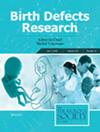Neural tube defects (NTDs) are the second most common congenital malformation. Periconceptional, prenatal, and perinatal interventions have been implemented to reduce their incidence and improve those affected's survival and quality of life. The study aims to describe this population's prevalence, interventions performed, clinical management, and perinatal outcomes.
A retrospective review of all prenatally diagnosed neural tube defect cases from January 2018 to April 2024 at a perinatal referral center in Mexico City was conducted.
One hundred seventy-two cases were identified with a prevalence of 9.8/1000 births, including anencephaly (17.26%), myeloschisis (8.63%), myelomeningocele (56.83%), encephalocele (12.94%), meningocele (4.31%) and lipomyelomeningocele (0.71%), with a median gestational age at diagnosis of 28.4 weeks; 39.57% had normal pregestational weight. Maternal characteristics in the sample included epilepsy (4.32%), diabetes (15.83%), history of a child with NTD (1.43%), exposure to teratogens (4.32%), and folic acid intake after 8 weeks gestation (21.58%). Myelomeningocele had a higher survival rate to discharge of 93.40%, as well as associated defects (53.1%), with bilateral clubfoot being the highest (29.1%); Nine patients (6.47%) received palliative care. The median in-hospital length of stay was 21.5 days. Post-surgical complications were reported in 10.9% of patients with myelomeningocele. 25.8% received pediatric rehabilitation assessment, 5.7% presented with neurogenic bladder, and 3rd-level hospitals were the highest referral units.
Managing NTDs involves preconception strategies, prenatal diagnosis, postnatal care, timely surgical interventions, and early pediatric rehabilitation. Likewise, proper referral to complex tertiary care to manage complications and additional morbidity in these cases could improve short- and long-term patient outcomes.



